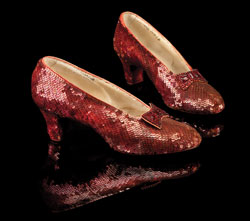By MCN Editor editor@moviecitynews.com
“OZ” RUBY SLIPPERS FIND THEIR WAY HOME: MAJOR ACQUISITION FOR ACADEMY MUSEUM OF MOTION PICTURES
February 22, 2012
FOR IMMEDIATE RELEASE
Leonardo DiCaprio spearheads effort with help from Steven Spielberg, Terry Semel
 Beverly Hills, CA – The Academy of Motion Picture Arts and Sciences has acquired a pair of the iconic ruby slippers from “The Wizard of Oz” for the Academy Museum of Motion Pictures. Actor Leonardo DiCaprio led a group of “angel donors” whose gifts to the Academy Foundation enabled the purchase. In addition to the Leonardo DiCaprio Foundation, a component fund of CCF Environmental and Humanitarian Causes, donations came from producer-director Steven Spielberg and Terry Semel, co-chair of LACMA and the former chairman and CEO of Warner Bros. and Yahoo!, along with other donors.
Beverly Hills, CA – The Academy of Motion Picture Arts and Sciences has acquired a pair of the iconic ruby slippers from “The Wizard of Oz” for the Academy Museum of Motion Pictures. Actor Leonardo DiCaprio led a group of “angel donors” whose gifts to the Academy Foundation enabled the purchase. In addition to the Leonardo DiCaprio Foundation, a component fund of CCF Environmental and Humanitarian Causes, donations came from producer-director Steven Spielberg and Terry Semel, co-chair of LACMA and the former chairman and CEO of Warner Bros. and Yahoo!, along with other donors.
“The ruby slippers occupy an extraordinary place in the hearts of movie audiences the world over,” said Bob Iger, president and CEO of the Walt Disney Co. and chair of the capital campaign for the Academy Museum of Motion Pictures. “This is a transformative acquisition for our collection.”
“Leo’s passionate leadership has helped us bring home this legendary piece of movie history,” added Academy CEO Dawn Hudson. “It’s a wonderful gift to the Academy museum project, and a perfect representation of the work we do year-round to preserve and share our film heritage.”
These slippers, known as the “Witch’s Shoes,” are in the most pristine condition of the four pairs of ruby slippers known to exist. It is widely believed that these are the slippers Judy Garland wore in close-ups and insert shots, most famously when Dorothy clicks her heels three times to return to Kansas. They are called the “Witch’s Shoes” because they are likely the pair seen on the feet of the Wicked Witch of the East after Dorothy’s house falls on the witch.
After production of the film ended in 1939, the ruby slippers were stored on MGM’s Culver City lot for the next three decades. Several pairs of slippers were discovered in 1970 by costumer Kent Warner while he was preparing for that year’s historic auction of MGM costumes, props and other production-related items. One pair of slippers was sold at the auction and was donated anonymously to the Smithsonian in 1979.
Warner kept the finest pair – the “Witch’s Shoes” – in his private collection for more than a decade before selling them at auction in 1981. They were sold again in 1988 to another private collector, and have been displayed publicly only a handful of times in the years since, most notably at the National Portrait Gallery and the Library of Congress. The 2012 sale to the Academy was handled by auction house Profiles in History.
Last October, the Academy and the Los Angeles County Museum of Art announced plans to establish the Academy Museum of Motion Pictures inside the historic May Company building, currently known as LACMA West. The building has been a Los Angeles landmark since its opening in 1939, the same year “The Wizard of Oz” premiered.
# # #
ABOUT THE ACADEMY
The Academy of Motion Picture Arts and Sciences is the world’s preeminent movie-related organization, with a membership of more than 6,000 of the most accomplished men and women working in cinema. In addition to the annual Academy Awards—in which the members vote to select the nominees and winners—the Academy presents a diverse year-round slate of public programs, exhibitions and events; provides financial support to a wide range of other movie-related organizations and endeavors; acts as a neutral advocate in the advancement of motion picture technology; and, through its Margaret Herrick Library and Academy Film Archive, collects, preserves, restores and provides access to movies and items related to their history. Through these and other activities the Academy serves students, historians, the entertainment industry and people everywhere who love movies.
FOLLOW THE ACADEMY
www.oscars.org
www.facebook.com/TheAcademy
www.youtube.com/Oscars
www.twitter.com/TheAcademy
AWARDS PUBLICITY
8949 WILSHIRE BOULEVARD | BEVERLY HILLS, CA 90211-1907













